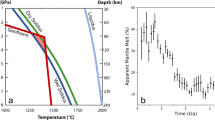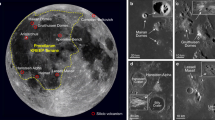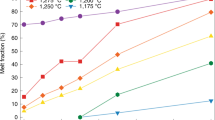Abstract
The Earth is in a plate tectonics regime with high surface heat flow concentrated at constructive plate boundaries. Other terrestrial bodies that lack plate tectonics are thought to lose their internal heat by conduction through their lids and volcanism: hotter planets (Io and Venus) show widespread volcanism whereas colder ones (modern Mars and Mercury) are less volcanically active. However, studies of terrestrial magmatic processes show that less than 20% of melt volcanically erupts, with most melt intruding into the crust. Signatures of large magmatic intrusions are also found on other planets. Yet, the influence of intrusive magmatism on planetary cooling remains unclear. Here we use numerical magmatic-thermo-mechanical models to simulate global mantle convection in a planetary interior. In our simulations, warm intrusive magmatism acts to thin the lithosphere, leading to sustained recycling of overlying crustal material and cooling of the mantle. In contrast, volcanic eruptions lead to a thick lithosphere that insulates the upper mantle and prevents efficient cooling. We find that heat loss due to intrusive magmatism can be particularly efficient compared to volcanic eruptions if the partitioning of heat-producing radioactive elements into the melt phase is weak. We conclude that the mode of magmatism experienced by rocky bodies determines the thermal and compositional evolution of their interior.
This is a preview of subscription content, access via your institution
Access options
Access Nature and 54 other Nature Portfolio journals
Get Nature+, our best-value online-access subscription
$29.99 / 30 days
cancel any time
Subscribe to this journal
Receive 12 print issues and online access
$259.00 per year
only $21.58 per issue
Buy this article
- Purchase on Springer Link
- Instant access to full article PDF
Prices may be subject to local taxes which are calculated during checkout



Similar content being viewed by others
References
Schubert, G., Turcotte, D. L. & Olson, P. Mantle Convection in the Earth and Planets (Cambridge Univ. Press, Cambridge, 2001).
Turcotte, D. L. & Schubert, G. Geodynamics (Cambridge Univ. Press, Cambridge, 2014).
Ruiz, J. et al. The thermal evolution of Mars as constrained by paleo-heat flows. Icarus 215, 508–517 (2011).
Warren, P. H. & Rasmussen, K. L. Megaregolith insulation, internal temperatures, and bulk uranium content of the moon. J. Geophys. Res. Solid Earth 92, 3453–3465 (1987).
Veeder, G. J., Matson, D. L., Johnson, T. V., Davies, A. G. & Blaney, D. L. The polar contribution to the heat flow of Io. Icarus 169, 264–270 (2004).
Peale, S. J., Cassen, P. & Reynolds, R. T. Melting of Io by tidal dissipation. Science 203, 892–894 (1979).
O'Reilly, T. C. & Davies, G. F. Magma transport of heat on Io: a mechanism allowing a thick lithosphere. Geophys. Res. Lett. 8, 313–316 (1981).
Breuer, D. & Moore, W. B. in Treatise on Geophysics (ed. Schubert, G.) 299–348 (Elsevier, Oxford, 2007).
Moore, W. B. & Webb, A. A. G. Heat-pipe Earth. Nature 501, 501–505 (2013).
Gerya, T. Introduction to Numerical Geodynamic Modelling (Cambridge Univ. Press, Cambridge, 2010).
Hofmann, A. W. Mantle geochemistry: the message from oceanic volcanism. Nature 385, 219–229 (1997).
Ogawa, M. Effects of chemical fractionation of heat-producing elements on mantle evolution inferred from a numerical-model of coupled magmatism mantle convection system. Phys. Earth Planet. Inter. 83, 101–127 (1994).
Xie, S. & Tackley, P. J. Evolution of U-Pb and Sm-Nd systems in numerical models of mantle convection and plate tectonics. J. Geophys. Res. Planets 109, B11204 (2004).
Nakagawa, T. & Tackley, P. J. Deep mantle heat flow and thermal evolution of the Earth's core in thermochemical multiphase models of mantle convection. Geochem. Geophys. Geosyst. 6, Q08003 (2005).
Kite, E. S., Manga, M. & Gaidos, E. Geodynamics and rate of volcanism on massive Earth-like planets. Astrophys. J. 700, 1732–1749 (2009).
Ogawa, M. A positive feedback between magmatism and mantle upwelling in terrestrial planets: implications for the Moon. J. Geophys. Res. Planets 119, 2317–2330 (2014).
Lourenço, D. L., Rozel, A. & Tackley, P. J. Melting-induced crustal production helps plate tectonics on Earth-like planets. Earth Planet. Sci. Lett. 439, 18–28 (2016).
Armann, M. & Tackley, P. J. Simulating the thermochemical magmatic and tectonic evolution of Venus's mantle and lithosphere: two-dimensional models. J. Geophys. Res. Planets 117, E12003 (2012).
Crisp, J. A. Rates of magma emplacement and volcanic output. J. Volcanol. Geotherm. Res. 20, 177–211 (1984).
Cawood, P. A., Hawkesworth, C. J. & Dhuime, B. The continental record and the generation of continental crust. Bull. Geol. Soc. Am. 125, 14–32 (2013).
Gerya, T. V. Plume-induced crustal convection: 3D thermomechanical model and implications for the origin of novae and coronae on Venus. Earth Planet. Sci. Lett. 391, 183–192 (2014).
Stofan, E. R., Smrekar, S. E., Tapper, S. W., Guest, J. E. & Grindrod, P. M. Preliminary analysis of an expanded corona database for Venus. Geophys. Res. Lett. 28, 4267–4270 (2001).
Glaze, L. S., Stofan, E. R., Smrekar, S. E. & Baloga, S. M. Insights into corona formation through statistical analyses. J. Geophys. Res. Planets 107, 18–12 (2002).
Krassilnikov, A. S. & Head, J. W. Novae on Venus: geology, classification, and evolution. J. Geophys. Res. Planets 108, 5108 (2003).
Rozel, A. B., Golabek, G. J., Jain, C., Tackley, P. J. & Gerya, T. Continental crust formation on early Earth controlled by intrusive magmatism. Nature 545, 332–335 (2017).
Tackley, P. J. Modelling compressible mantle convection with large viscosity contrasts in a three-dimensional spherical shell using the yin-yang grid. Phys. Earth Planet. Inter. 171, 7–18 (2008).
Hernlund, J. W. & Tackley, P. J. Modeling mantle convection in the spherical annulus. Phys. Earth Planet. Inter. 171, 48–54 (2008).
Kaufmann, G. & Lambeck, K. Mantle dynamics, postglacial rebound and the radial viscosity profile. Phys. Earth Planet. Inter. 121, 301–324 (2000).
Mitrovica, J. X. & Forte, A. M. A new inference of mantle viscosity based upon joint inversion of convection and glacial isostatic adjustment data. Earth Planet. Sci. Lett. 225, 177–189 (2004).
Sleep, N. H. Segregation of magma from a mostly crystalline Mush. Bull. Geol. Soc. Am. 85, 1225–1232 (1974).
McKenzie, D. The generation and compaction of partially molten rock. J. Petrol. 25, 713–765 (1984).
Fowler, A. C. A mathematical model of magma transport in the asthenosphere. Geophys. Astrophys. Fluid Dyn. 33, 63–96 (1985).
Scott, D. R. & Stevenson, D. J. Magma ascent by porous flow. J. Geophys. Res. Solid Earth 91, 9283–9296 (1986).
Bercovici, D., Ricard, Y. & Schubert, G. A two-phase model for compaction and damage: 1. general theory. J. Geophys. Res. Solid Earth 106, 8887–8906 (2001).
Keller, T., May, D. A. & Kaus, B. J. P. Numerical modelling of magma dynamics coupled to tectonic deformation of lithosphere and crust. Geophys. J. Int. 195, 1406–1442 (2013).
O’Neill, C., Moresi, L. & Lenardic, A. Insulation and depletion due to thickened crust: effects on melt production on Mars and Earth. Geophys. Res. Lett. 32, L14304 (2005).
Cooper, C. M., Lenardic, A. & Moresi, L. Effects of continental insulation and the partitioning of heat producing elements on the Earth’s heat loss. Geophys. Res. Lett. 33, 4741 (2006).
Deschamps, F., Cobden, L. & Tackley, P. J. The primitive nature of large low shear-wave velocity provinces. Earth Planet. Sci. Lett. 349, 198–208 (2012).
Gerya, T. V. & Burg, J.-P. Intrusion of ultramafic magmatic bodies into the continental crust: Numerical simulation. Phys. Earth Planet. Inter. 160, 124–142 (2007).
Wood, B. J. & Blundy, J. D. in Treatise on Geochemistry (eds Holland, H. D. & Turekian, K. K.) 395–424 (Elsevier, Oxford, 2003).
Lenardic, A. in Archean Geodynamics and Environments Vol. 164 (eds Benn, K. et al.) 33–45 (American Geophysical Union, 2006).
van Hunen, J. & van den Berg, A. P. Plate tectonics on the early Earth: limitations imposed by strength and buoyancy of subducted lithosphere. Lithos 103, 217–235 (2008).
Christensen, U. R. Thermal evolution models for the Earth. J. Geophys. Res. Solid Earth 90, 2995–3007 (1985).
Valencia, D., O’Connell, R. J. & Sasselov, D. D. Inevitability of plate tectonics on super-Earths. Astrophys. J. 670, L45–L48 (2007).
SteinC.., FinnenkötterA.., LowmanJ. P.. & HansenU.. The pressure-weakening effect in super-Earths: consequences of a decrease in lower mantle viscosity on surface dynamics. Geophys. Res. Lett. 38, L21201 (2011).
van Heck, H. J. & Tackley, P. J. Plate tectonics on super-Earths: equally or more likely than on Earth. Earth Planet. Sci. Lett. 310, 252–261 (2011).
Tackley, P. J., Ammann, M., Brodholt, J. P., Dobson, D. P. & Valencia, D. Mantle dynamics in super-Earths: post-perovskite rheology and self-regulation of viscosity. Icarus 225, 50–61 (2013).
Dorn, C. et al. Can we constrain the interior structure of rocky exoplanets from mass and radius measurements? Astron. Astrophys. 577, A83 (2015).
Balay, S., Brown, J., Buschelman, K. & Eijkhout, V. PETSc Users Manual Revision 3.3 (Argonne National Laboratory, 2012).
Buffett, B. A., Huppert, H. E., Lister, J. R. & Woods, A. W. Analytical model for solidification of the Earth’s core. Nature 356, 329–331 (1992).
Buffett, B. A., Huppert, H. E., Lister, J. R. & Woods, A. W. On the thermal evolution of the Earth’s core. J. Geophys. Res. Solid Earth 101, 7989–8006 (1996).
Nakagawa, T. & Tackley, P. J. Effects of thermo-chemical mantle convection on the thermal evolution of the Earth’s core. Earth Planet. Sci. Lett. 220, 107–119 (2004).
Irifune, T. & Ringwood, A. E. Phase transformations in subducted oceanic crust and buoyancy relationships at depths of 600–800 km in the mantle. Earth Planet. Sci. Lett. 117, 101–110 (1993).
Ono, S., Ito, E. & Katsura, T. Mineralogy of subducted basaltic crust (MORB) from 25 to 37 GPa, and chemical heterogeneity of the lower mantle. Earth Planet. Sci. Lett. 190, 57–63 (2001).
Nakagawa, T. & Tackley, P. J. Influence of magmatism on mantle cooling, surface heat flow and Urey ratio. Earth Planet. Sci. Lett. 329-330, 1–10 (2012).
Herzberg, C., Raterron, P. & Zhang, J. New experimental observations on the anhydrous solidus for peridotite KLB-1. Geochem. Geophys. Geosyst., https://doi.org/10.1029/2000GC000089 (2000).
Zerr, A., Diegeler, A. & Boehler, R. Solidus of Earth’s deep mantle. Science 281, 243–246 (1998).
Condomines, M., Hemond, C. & Allegre, C. J. U-Th-Ra radioactive disequilibria and magmatic processes. Earth Planet. Sci. Lett. 90, 243–262 (1988).
Vogt, K., Gerya, T. V. & Castro, A. Crustal growth at active continental margins: numerical modeling. Phys. Earth Planet. Inter. 192-193, 1–20 (2012).
Karato, S. I. & Wu, P. Rheology of the upper mantle: a synthesis. Science 260, 771–778 (1993).
Yamazaki, D. & Karato, S.-I. Some mineral physics constraints on the rheology and geothermal structure of Earth’s lower mantle. Am. Mineral. 86, 385–391 (2001).
Čížková, H., van den Berg, A. P., Spakman, W. & Matyska, C. The viscosity of Earth’s lower mantle inferred from sinking speed of subducted lithosphere. Phys. Earth Planet. Inter. 200–201, 56–62 (2012).
Ammann, M. W., Brodhot, J. P., Wookey, J. & Dobson, D. P. First-principles constraints on diffusion in lower-mantle minerals and a weak D˝ layer. Nature 465, 462–465 (2010).
Herzberg, C., Condie, K. & Korenaga, J. Thermal history of the Earth and its petrological expression. Earth Planet. Sci. Lett. 292, 79–88 (2010).
Abe, Y. in Evolution of the Earth and Planets Vol. 74 (eds Takahashi, E. et al.) 41–54 (American Geophysical Union, 1993).
Arzi, A. A. Critical phenomena in the rheology of partially melted rocks. Tectonophysics 44, 173–184 (1978).
Costa, A., Caricchi, L. & Bagdassarov, N. A model for the rheology of particle-bearing suspensions and partially molten rocks. Geochem. Geophys. Geosyst. 10, Q03010 (2009).
Acknowledgements
We thank A. Püsök, G. Golabek and S. Labrosse for reading an earlier version of the manuscript. D.L.L. was supported by ETH Zurich grant ETH-46 12-1. A.B.R. and P.J.T. received funding from the European Research Council under the European Union’s Seventh Framework Programme (FP/2007-2013)/ERC Grant Agreement no. 320639 project iGEO. T.G. received funding from the European Union’s Horizon 2020 research and innovation programme under the Marie Sklodowska-Curie grant agreements no. 642029-ITN CREEP and no. 674899 SUBITOP.
Author information
Authors and Affiliations
Contributions
D.L.L., A.B.R and T.G. designed the set of numerical simulations. P.J.T. implemented the eruption–intrusion routines on the convection code and initiated this general research direction. D.L.L. wrote the post-processing routines. D.L.L. and A.B.R. produced the figures. All authors contributed to the manuscript.
Corresponding author
Ethics declarations
Competing interests
The authors declare no competing interests.
Additional information
Publisher’s note: Springer Nature remains neutral with regard to jurisdictional claims in published maps and institutional affiliations.
Supplementary information
Supplementary Information
Supplementary Figure
Rights and permissions
About this article
Cite this article
Lourenço, D.L., Rozel, A.B., Gerya, T. et al. Efficient cooling of rocky planets by intrusive magmatism. Nature Geosci 11, 322–327 (2018). https://doi.org/10.1038/s41561-018-0094-8
Received:
Accepted:
Published:
Issue Date:
DOI: https://doi.org/10.1038/s41561-018-0094-8
This article is cited by
-
Estranged planetary twins
Nature Geoscience (2023)
-
Venus, the Planet: Introduction to the Evolution of Earth’s Sister Planet
Space Science Reviews (2023)
-
The Habitability of Venus
Space Science Reviews (2023)
-
Hadean/Eoarchean tectonics and mantle mixing induced by impacts: a three-dimensional study
Progress in Earth and Planetary Science (2022)
-
Ariel planetary interiors White Paper
Experimental Astronomy (2022)



